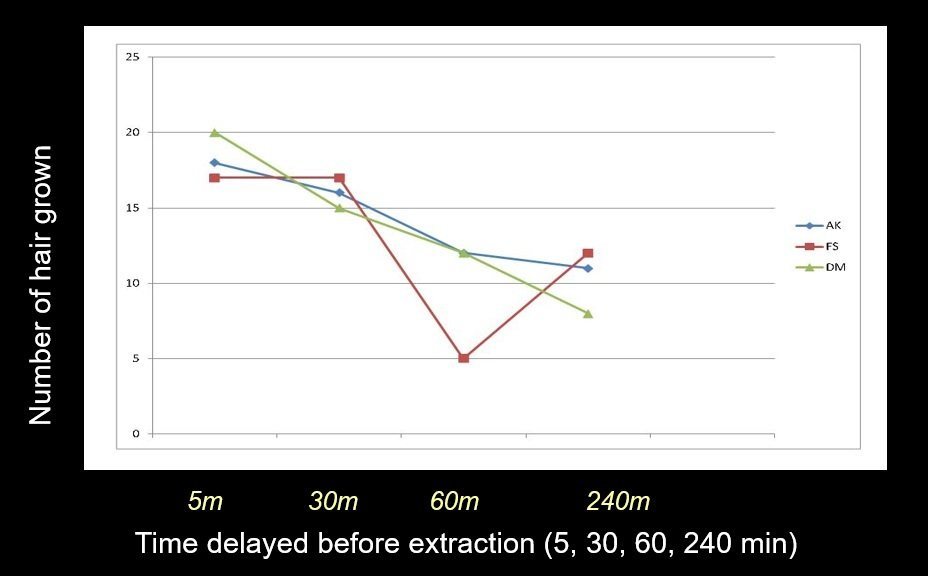The Effects of Delay in Extracting Follicular Units on the Viability of FUE Grafts
ABSTRACT:
Introduction:
The techniques of Follicular Unit Extraction (FUE) hair transplantation have been improved over the last several years with the emergence of motorized and automated FUE devices. Since FUE is relatively a new technique in hair restoration, there are many questions that have yet to be answered.
 Objective:
Objective:
To determine how long can FUE grafts survive inside scalp skin after punching and before extraction? The importance of this question is further underscored when using automated FUE devices. In many cases it is more efficient to score a large number of FUE grafts before pulling them out in both manual and automated FUE procedures. But how long can grafts stay in place before they are extracted and transplanted? Five minutes, ten minutes; or perhaps a surgeon and team can wait for one or even several hours before extracting the grafts. At present we do not have an adequate scientific answer to the optimum duration or time lapse from punching the grafts until necessary extraction. The FUE Delayed Extraction study was designed and performed to answer these crucial questions.
 Material and methods:
Material and methods:
We performed hair transplant on study patients with FUE or strip as we do routinely. Along the main operation, we punched (scored) several FUE grafts on the permanent zone of the occipital area. Then we extracted hair follicular units from the scored areas in intervals of 5 min., 30 min. 1 Hr and 4 Hrs after initial scoring. For the purpose of this study and to be consistent with our results, we chose only grafts that have two intact hair follicles. The grafts were placed into four marked areas on the top or crown areas where no terminal hair was present. We implanted ten, 2-hair grafts in each one square centimeter marked box. We placed the marked areas around a tattooed dot for ease of locating them in follow up visits. We did not transplant any grafts in 0.5cm space between and around each box in order to be able to view and assess the follicular units in the study boxes. Patients were scheduled for one day, ten days, 6 and 12 months post hair transplantation evaluation and assessment.
We utilized the following inclusion criteria to select the patients for this study. Men with Typical Male Patterned Baldness Patients with at least one 3 x 3 cm area on the top and crown with total baldness (No visible hair) Patients with at least 50% pigmented hair.
Results:
The results of the FUE delayed Extraction Study will be discussed during the ISHRS annual meeting.
 Conclusion:
Conclusion:
Survival of grafts during a hair transplant procedure is one of the most essential elements for optimum outcome. It might be presumed by many hair transplant surgeons that scoring and leaving the grafts in place do not affect the survival of the grafts due to the presence of perfusion around the grafts. However, this has never been previously documented. We will discuss the ideal timing between the scoring; extracting and implanting FUE grafts in subsequent presentation.
Bio:
Parsa Mohebi, MD, is the medical director of Parsa Mohebi Hair Restoration. He completed his surgical residency at the University of New Mexico and York Hospital, Pennsylvania. Dr. Mohebi served as a research fellow at John Hopkins School of Medicine, Department of Surgical Sciences. He performed several studies on wound healing and hair growth, utilizing growth factors and gene therapy methods. He completed his fellowship in surgical hair restoration at the New Hair Institute (NHI.) Parsa Mohebi, MD is a Diplomate of the American Board of Hair Restoration Surgery.
This publication was presented by Dr. Parsa Mohebi at the International Society of Hair Restoration Surgeries 20th Annual Scientific Meeting in Nassau, Bahamas.